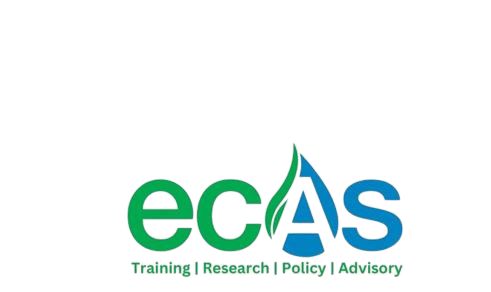
INTERNATIONAL TRAINING ON CLOUD COMPUTING FUNDAMENTALS FOR ENVIRONMENTAL DATA
COURSE BACKGROUND
The environmental sector is experiencing an unprecedented explosion of data from diverse sources: high-resolution satellite imagery, vast sensor networks, climate models, biodiversity databases, and citizen science initiatives. Managing, processing, and analyzing these massive datasets using traditional on-premise infrastructure often proves prohibitive in terms of cost, scalability, and computational power. Cloud computing offers a transformative solution, providing on-demand, scalable, and cost-effective resources for storage, processing, and analysis of environmental data. Understanding cloud fundamentals is therefore becoming essential for environmental professionals seeking to leverage cutting-edge analytics, collaborate effectively, and drive data-driven environmental solutions.
ECAS Institute offers this “Cloud Computing Fundamentals for Environmental Data” course to equip environmental scientists, data analysts, GIS specialists, and researchers with a foundational understanding of cloud computing concepts and their practical application to environmental data challenges. This program will demystify cloud services, enabling participants to harness the power of scalable infrastructure for their environmental data management and analytical needs.
COURSE OBJECTIVES OF THE TRAINING
Upon successful completion of this course, participants will be able to:
- Understand the core concepts and benefits of cloud computing (scalability, elasticity, cost-effectiveness) for environmental applications.
- Differentiate between various cloud service models (IaaS, PaaS, SaaS) and deployment options (public, private, hybrid).
- Identify and utilize cloud storage solutions for different types of environmental data (e.g., imagery, time-series, tabular data).
- Understand basic cloud computing resources (virtual machines, containers, serverless functions) for environmental data processing.
- Explore cloud-based analytics services relevant to environmental data (e.g., geospatial analysis, Big Data processing).
- Recognize fundamental cloud security and governance principles for protecting sensitive environmental information.
- Articulate real-world use cases where cloud computing is transforming environmental research and management.
WHAT YOU WILL LEARN
This course will provide you with a practical and conceptual understanding of cloud computing specifically tailored for working with environmental data. You will learn to:
- Grasp the fundamental architecture of cloud platforms and how they differ from traditional IT infrastructure.
- Identify appropriate cloud storage solutions for your environmental datasets, considering data volume, access frequency, and cost.
- Understand how to provision and utilize basic compute resources in the cloud for running environmental models or analyses.
- Navigate common cloud provider interfaces (e.g., a leading cloud provider like AWS, Azure, or GCP – conceptually and with simple exercises).
- Explore cloud services for Big Data processing and analytics that are well-suited for large environmental datasets.
- Understand key considerations for data security and privacy when storing and processing environmental data in the cloud.
- Evaluate the cost implications of different cloud services and strategies for cost optimization.
- Discover how leading environmental organizations are already leveraging cloud computing for climate modeling, conservation, and pollution monitoring.
DURATION AND PROGRAM
This is a structured training course designed to provide a foundational understanding of cloud computing concepts with a strong emphasis on their relevance to environmental data. The program will combine theoretical explanations with practical demonstrations and guided exercises using accessible cloud interfaces or simulated environments. Participants are encouraged to have basic computer literacy. The detailed program schedule, including specific session timings and learning activities, will be communicated upon registration.
TARGET PARTICIPANTS
This course is ideal for environmental professionals, researchers, and data managers who need to understand and leverage cloud computing for their work. It is particularly beneficial for:
- Environmental Scientists and Researchers dealing with large datasets.
- GIS Analysts and Remote Sensing Specialists
- Environmental Data Analysts and Managers
- Climate Modelers and Hydrologists
- Conservation Biologists managing species data
- IT Professionals supporting environmental organizations
- Students in environmental science, data science, and related fields.
- Anyone interested in scalable solutions for environmental data challenges.
TRAINING MODULES
The course is structured to provide a clear and progressive understanding of cloud computing for environmental data:
| No | Module | Details | |
| 1. | Introduction to Cloud Computing and Environmental Data |
This module sets the stage by introducing the concept of cloud computing and highlighting why it is becoming indispensable for managing and analyzing vast environmental datasets.
Topics:
|
|
| 2. | Cloud Service Models and Deployment Options |
This module differentiates between the various ways cloud services are offered and how cloud environments can be deployed to meet specific organizational needs.
Topics:
|
|
| 3. | Cloud Storage for Environmental Data |
This module focuses on the diverse options available for storing different types of environmental data efficiently and cost-effectively in the cloud.
Topics:
|
|
| 4. | Cloud Computing and Networking Basics |
This module introduces the fundamental computational resources and networking concepts within cloud environments that enable data processing.
Topics:
|
|
|
5.
|
Cloud Data Processing and Analytics Services |
This module explores cloud services specifically designed for analyzing large-scale environmental datasets, including geospatial and Big Data analytics.
Topics:
|
|
| 6. | Cloud Security and Governance for Environmental Data |
This module highlights the critical aspects of securing environmental data and ensuring proper governance within a cloud environment.
Topics:
|
|
| 7. | Environmental Applications & Case Studies of Cloud Computing |
This module brings together the learned concepts through real-world examples of how cloud computing is being effectively applied in various environmental domains.
Topics:
|
|
TRAINING STYLE
The modules will be taught through PowerPoint presentations, and lectures and will include a case study/field visit, breakout sessions, case studies and other interactive discussion components.
The course will also include a few guest speakers, both in person and via Zoom and other online learning platforms for overseas speakers. This provides useful real-world insights alongside the more theoretical aspects of the course.
The conference faculty shall consist of experienced decision makers, as well as practitioners and representatives from established educational and research institutions active around climate change, engineering and international development. Throughout the course, theoretical presentation of concepts will be moderated and more group discussions and plenary engagements will be optimized. PowerPoint presentations will be made by facilitators and resource persons, to highlight key concepts before embarking on group work.
GENERAL NOTES
- Training manuals and additional reference materials are provided to the participants.
- Upon successful completion of this course, participants will be issued with a certificate.
- We can also do this as a tailor-made course to meet organization-wide needs. Contact us to find out more: info@ecasiafrica.org.
- Payment should be sent to our bank account before the start of training and proof of payment sent to: info@ecasiafrica.org.
ABOUT ECAS INSTITUTE
The ECAS Institute designs and delivers independent and targeted training, research, and consulting services. Our work focusses on climate change and resilience building, carbon markets, renewable energy, nature-based solution, biodiversity conservation, agriculture and food systems, We are located in Nairobi Kenya and work across the African region. We have implemented training and research assignments in Kenya, Tanzania, Uganda, South Sudan, Somalia, Malawi, Rwanda, Congo, and South Africa. Globally, we have supported our partners from the UK, Denmark, Italy, Sweden, Germany, and USA.
